Balancing Urban Expansion and Food Security: A Spatiotemporal Assessment of Cropland Loss and Productivity Compensation in the Yangtze River Delta, China
Abstract
1. Introduction
2. Materials and Methods
2.1. Study Area
2.2. Data Sources
2.3. Methodology
3. Results
3.1. Grain Yield Losses Due to Cropland Conversion
3.2. Estimated Grain Yield from Reclaimed Cropland
3.3. Grain Yield Changes on Stable Cropland
4. Discussion
4.1. Impacts of Urbanization on Grain Yield from Cropland
4.2. The Importance of “Safeguarding Grain in Land and Technology”
4.3. Limitations
5. Conclusions
Author Contributions
Funding
Data Availability Statement
Conflicts of Interest
References
- Qureshi, M.E.; Dixon, J.; Wood, M. Public Policies for Improving Food and Nutrition Security at Different Scales. Food Secur. 2015, 7, 393–403. [Google Scholar] [CrossRef]
- Andrews, E.; Sanderson Bellamy, A. Putting Food in the Driver’s Seat: Aligning Food-Systems Policy to Advance Sustainability, Health, and Security. Front. Sustain. Food Syst. 2023, 7, 1204194. [Google Scholar] [CrossRef]
- Qiao, J.; Cao, Q.; Zhang, Z.; Cao, Z.; Liu, H. Spatiotemporal Changes in the State of Food Security across Mainland China during 1990–2015: A Multi-Scale Analysis. Food Energy Secur. 2022, 11, e318. [Google Scholar] [CrossRef]
- Wang, S.; Wu, H.; Li, J.; Xiao, Q.; Li, J. Assessment of the Effect of the Main Grain-Producing Areas Policy on China’s Food Security. Foods 2024, 13, 654. [Google Scholar] [CrossRef] [PubMed]
- Lu, Y.; He, T.; Yue, W.; Li, M.; Shan, Z.; Zhang, M. Does Cropland Threaten Urban Land Use Efficiency in the Peri-Urban Area? Evidence from Metropolitan Areas in China. Appl. Geogr. 2023, 161, 103124. [Google Scholar] [CrossRef]
- Ma, C.; Li, M.; Jiang, P. The Multiscale Response of Global Cropland Cropping Intensity to Urban Expansion. Agric. Syst. 2024, 221, 104138. [Google Scholar] [CrossRef]
- Duan, J.; Ren, C.; Wang, S.; Zhang, X.; Reis, S.; Xu, J.; Gu, B. Consolidation of Agricultural Land Can Contribute to Agricultural Sustainability in China. Nat. Food 2021, 2, 1014–1022. [Google Scholar] [CrossRef]
- Liu, Y.; Zhou, Y. Reflections on China’s Food Security and Land Use Policy under Rapid Urbanization. Land Use Policy 2021, 109, 105699. [Google Scholar] [CrossRef]
- D’Amour, C.B.; Reitsma, F.; Baiocchi, G.; Barthel, S.; Güneralp, B.; Erb, K.H.; Haberl, H.; Creutzig, F.; Seto, K.C. Future Urban Land Expansion and Implications for Global Croplands. Proc. Natl. Acad. Sci. USA 2017, 114, 8939–8944. [Google Scholar] [CrossRef]
- Xie, Y.; Hunter, M.; Sorensen, A.; Nogeire-McRae, T.; Murphy, R.; Suraci, J.P.; Lischka, S.; Lark, T.J. U.S. Farmland under Threat of Urbanization: Future Development Scenarios to 2040. Land 2023, 12, 574. [Google Scholar] [CrossRef]
- Li, W.; Chen, Z.; Li, M.; Qiu, X.; Zhao, Q.Q.; Chen, Y. Spatial Conflict Identification and Scenario Coordination for Construction—Agricultural—Ecological Land Use. Environ. Dev. Sustain. 2025, 27, 1933–1961. [Google Scholar] [CrossRef]
- Potapov, P.; Turubanova, S.; Hansen, M.C.; Tyukavina, A.; Zalles, V.; Khan, A.; Song, X.P.; Pickens, A.; Shen, Q.; Cortez, J. Global Maps of Cropland Extent and Change Show Accelerated Cropland Expansion in the Twenty-First Century. Nat. Food 2022, 3, 19–28. [Google Scholar] [CrossRef]
- Han, J.; Bryan, B.A.; Zhang, Y. Strategic Cropland Reserves Can Strengthen China’s Food Security. Nat. Food 2024, 5, 535–538. [Google Scholar] [CrossRef] [PubMed]
- Tu, Y.; Chen, B.; Yu, L.; Xin, Q.; Gong, P.; Xu, B. How Does Urban Expansion Interact with Cropland Loss? A Comparison of 14 Chinese Cities from 1980 to 2015. Landsc. Ecol. 2021, 36, 243–263. [Google Scholar] [CrossRef]
- Chen, H.; Tan, Y.; Xiao, W.; Li, G.; Meng, F.; He, T.; Li, X. Urbanization in China Drives Farmland Uphill under the Constraint of the Requisition—Compensation Balance. Sci. Total Environ. 2022, 831, 154895. [Google Scholar] [CrossRef]
- Han, B.; Jin, X.; Yeting, F.; Chen, H.; Jin, J.; Xu, W.; Ren, J.; Zhou, Y. Trend and Spatial Pattern of Stable Cropland Productivity in China Based on Satellite Observations (2001–2020). Environ. Impact Assess. Rev. 2023, 101, 107136. [Google Scholar] [CrossRef]
- Li, C.; Chen, L.; Liu, D.; Wei, J.; He, J.; Duan, X. The Hidden Risk in China’s Cropland Conversion from the Perspective of Slope. Catena 2021, 206, 105536. [Google Scholar] [CrossRef]
- Liang, X.; Jin, X.; Dou, Y.; Zhang, X.; Li, H.; Wang, S.; Meng, F.; Tan, S.; Zhou, Y. Mapping Sustainability-Oriented China’s Cropland Use Stability. Comput. Electron. Agric. 2024, 219, 108823. [Google Scholar] [CrossRef]
- Abebe, M.G. Impacts of Urbanization on Food Security in Ethiopia. A Review with Empirical Evidence. J. Agric. Food Res. 2024, 15, 100997. [Google Scholar] [CrossRef]
- Wang, L.; Zhang, S.; Xiong, Q.; Liu, Y.; Liu, Y.; Liu, Y. Spatiotemporal Dynamics of Cropland Expansion and Its Driving Factors in the Yangtze River Economic Belt: A Nuanced Analysis at the County Scale. Land Use Policy 2022, 119, 106168. [Google Scholar] [CrossRef]
- Han, S.; Shao, Q.; Ning, J.; Jin, S. Spatio-Temporal Changes of Arable Land and Their Impacts on Grain Output in the Yangtze River Economic Belt from 1980 to 2020. Remote Sens. 2024, 16, 1672. [Google Scholar] [CrossRef]
- Ye, X.; Xiang, A.; Gao, R.; Chuai, X. The Impact of Spatiotemporal Change in Cropland Use on Local Urban Cereal Supply in China. Agric. Syst. 2025, 224, 104259. [Google Scholar] [CrossRef]
- Bedasa, Y.; Gemechu, A.; Bedemo, A.; Gebissa, B.; Xiuguang, B. Impacts of Climate and Non-Climate Factors on Cereal Crop Yield in East Africa: A Generalized Method of Moments (GMM) Panel Data Analysis. J. Agric. Food Res. 2025, 21, 101829. [Google Scholar] [CrossRef]
- Madolli, M.J.; Kanannavar, P.S.; Paul, N.C.; Gade, S.A.; Datta, A.; Himanshu, S.K. Assessing the Effects of Spatial Variability of Field Microtopography on Crop Yield, Soil Water, and Water Productivity Under Rainfed Sorghum Production System. Water Conserv. Sci. Eng. 2025, 10, 21. [Google Scholar] [CrossRef]
- Qiu, B.; Li, H.; Tang, Z.; Chen, C.; Berry, J. How Cropland Losses Shaped by Unbalanced Urbanization Process? Land Use Policy 2020, 96, 104715. [Google Scholar] [CrossRef]
- Shen, W.; Hu, Q.; Zhang, Z. Impacts of in Situ Urbanisation on Grain Production: Evidence from the Yangtze River Delta, China. Habitat Int. 2024, 143, 102989. [Google Scholar] [CrossRef]
- Shi, J.; Hua, W.; Duan, K.; Li, H. Evaluation of the Urban—Rural Integration Development Level in the Yangtze River Delta: A Hybrid Method. J. Urban Plan. Dev. 2023, 149, 04023026. [Google Scholar] [CrossRef]
- Zhen, Y.; Shi, D.; Lu, Y. The Impact of Regional Integration Strategies on the Formation of City Regions and Its Agglomeration Shadow: Evidence from the Yangtze River Delta, China. Land 2023, 12, 1053. [Google Scholar] [CrossRef]
- Han, G.; Yang, H.; Xie, H. Research on the Efficiency and Spatiotemporal Evolution Characteristics of Agricultural Green Development in Central Cities of the Yangtze River Delta. Front. Environ. Sci. 2024, 12, 1502824. [Google Scholar] [CrossRef]
- Tan, S.; Hu, B.; Kuang, B.; Zhou, M. Regional Differences and Dynamic Evolution of Urban Land Green Use Efficiency within the Yangtze River Delta, China. Land Use Policy 2021, 106, 105449. [Google Scholar] [CrossRef]
- Yang, Y.; Deng, Y.; Xie, X.; Wang, Y. Multiple Isotope Approach Elucidates the Calcium Enrichment of Groundwater in the Central Yangtze River Basin. Appl. Geochem. 2024, 166, 105979. [Google Scholar] [CrossRef]
- Yang, J.; Huang, X. The 30m Annual Land Cover Dataset and Its Dynamics in China from 1990 to 2019. Earth Syst. Sci. Data 2021, 13, 3907–3925. [Google Scholar] [CrossRef]
- Zhang, X.; Qiu, D.; Xie, Y.; Tu, J.; Lan, H.; Li, X.; Sha, Z. Diversified Responses of Vegetation Carbon Uptake to Urbanization: A National-Scale Analysis. Front. Ecol. Evol. 2023, 11, 1140455. [Google Scholar] [CrossRef]
- Huang, Q.; Liu, Z.; He, C.; Gou, S.; Bai, Y.; Wang, Y.; Shen, M. The Occupation of Cropland by Global Urban Expansion from 1992 to 2016 and Its Implications. Environ. Res. Lett. 2020, 15, 084037. [Google Scholar] [CrossRef]
- Shi, S.; Ye, Y.; Xiao, R. Evaluation of Food Security Based on Remote Sensing Data—Taking Egypt as an Example. Remote Sens. 2022, 14, 2876. [Google Scholar] [CrossRef]
- Gwal, S.; Sena, D.R.; Srivastava, P.K.; Srivastava, S.K. Identifying Conservation Priority Areas of Hydrological Ecosystem Service Using Hot and Cold Spot Analysis at Watershed Scale. Remote Sens. 2024, 16, 3409. [Google Scholar] [CrossRef]
- Igboeli, E.E.; Chukwuka, O.; Ochege, F.U.; Onyekwelu, C.A.; Ling, Q.; Ajaero, C.; Hamdi, R.; Rahman, M.; Kayiranga, A.; Luo, G. Combined Impacts of Land Change and Climate Variability on Ecosystem Net Primary Productivity in Arid Regions. Glob. Planet. Change 2025, 245, 104682. [Google Scholar] [CrossRef]
- Huang, Y.; Jin, Y.; Chen, S. The Spatiotemporal Dynamics of Vegetation Cover and Its Response to the Grain for Green Project in the Loess Plateau of China. Forests 2024, 15, 1949. [Google Scholar] [CrossRef]
- Liang, X.; Jin, X.; Xu, X.; Chen, H.; Liu, J.; Yang, X.; Xu, W.; Sun, R.; Han, B.; Zhou, Y. Uncertainty in China’s Food Self-Sufficiency: A Dynamic System Assessment. Sustain. Prod. Consum. 2023, 40, 135–146. [Google Scholar] [CrossRef]
- He, C.; Liu, Z.; Xu, M.; Ma, Q.; Dou, Y. Urban Expansion Brought Stress to Food Security in China: Evidence from Decreased Cropland Net Primary Productivity. Sci. Total Environ. 2017, 576, 660–670. [Google Scholar] [CrossRef]
- Liu, Y.; Ou, C.; Liu, Y.; Cao, Z.; Robinson, G.M.; Li, X. Unequal Impacts of Global Urban–Rural Settlement Construction on Cropland and Production over the Past Three Decades. Sci. Bull. 2025, 70, 1699–1709. [Google Scholar] [CrossRef]
- De Vos, K.; Janssens, C.; Jacobs, L.; Campforts, B.; Boere, E.; Kozicka, M.; Leclère, D.; Havlík, P.; Hemerijckx, L.M.; Van Rompaey, A.; et al. African Food System and Biodiversity Mainly Affected by Urbanization via Dietary Shifts. Nat. Sustain. 2024, 7, 869–878. [Google Scholar] [CrossRef]
- Hu, G.; Li, X.; Liu, X.; Wang, S.; Zhang, X.; Shi, X.; Bai, X.; Hubacek, K. Mitigating the Ripple Effects of Urbanization on Farmland Productivity and Ecological Security through Inclusive Urbanization Strategies. npj Urban Sustain. 2025, 5, 12. [Google Scholar] [CrossRef]
- Qiu, B.; Yang, X.; Tang, Z.; Chen, C.; Li, H.; Berry, J. Urban Expansion or Poor Productivity: Explaining Regional Differences in Cropland Abandonment in China during the Early 21st Century. Land Degrad. Dev. 2020, 31, 2540–2551. [Google Scholar] [CrossRef]
- Zheng, N.; Li, L.; Han, L.; Zhu, X.; Zhao, K.; Zhu, Z.; Ye, X. The Relationship between Farmland Abandonment and Urbanization Processes: A Case Study in Four Chinese Urban Agglomerations. Land 2024, 13, 664. [Google Scholar] [CrossRef]
- Zhou, B.B.; Aggarwal, R.; Wu, J.; Lv, L. Urbanization-Associated Farmland Loss: A Macro-Micro Comparative Study in China. Land Use Policy 2021, 101, 105228. [Google Scholar] [CrossRef]
- Li, S.; Ji, Q.; Liang, W.; Fu, B.; Lü, Y.; Yan, J.; Jin, Z.; Wang, Z.; Li, Y. Urbanization Does Not Endanger Food Security: Evidence from China’s Loess Plateau. Sci. Total Environ. 2023, 871, 162053. [Google Scholar] [CrossRef]
- Liu, X.; Xu, Y.; Engel, B.A.; Sun, S.; Zhao, X.; Wu, P.; Wang, Y. The Impact of Urbanization and Aging on Food Security in Developing Countries: The View from Northwest China. J. Clean. Prod. 2021, 292, 126067. [Google Scholar] [CrossRef]
- Wang, S.; Bai, X.; Zhang, X.; Reis, S.; Chen, D.; Xu, J.; Gu, B. Urbanization Can Benefit Agricultural Production with Large-Scale Farming in China. Nat. Food 2021, 2, 183–191. [Google Scholar] [CrossRef]

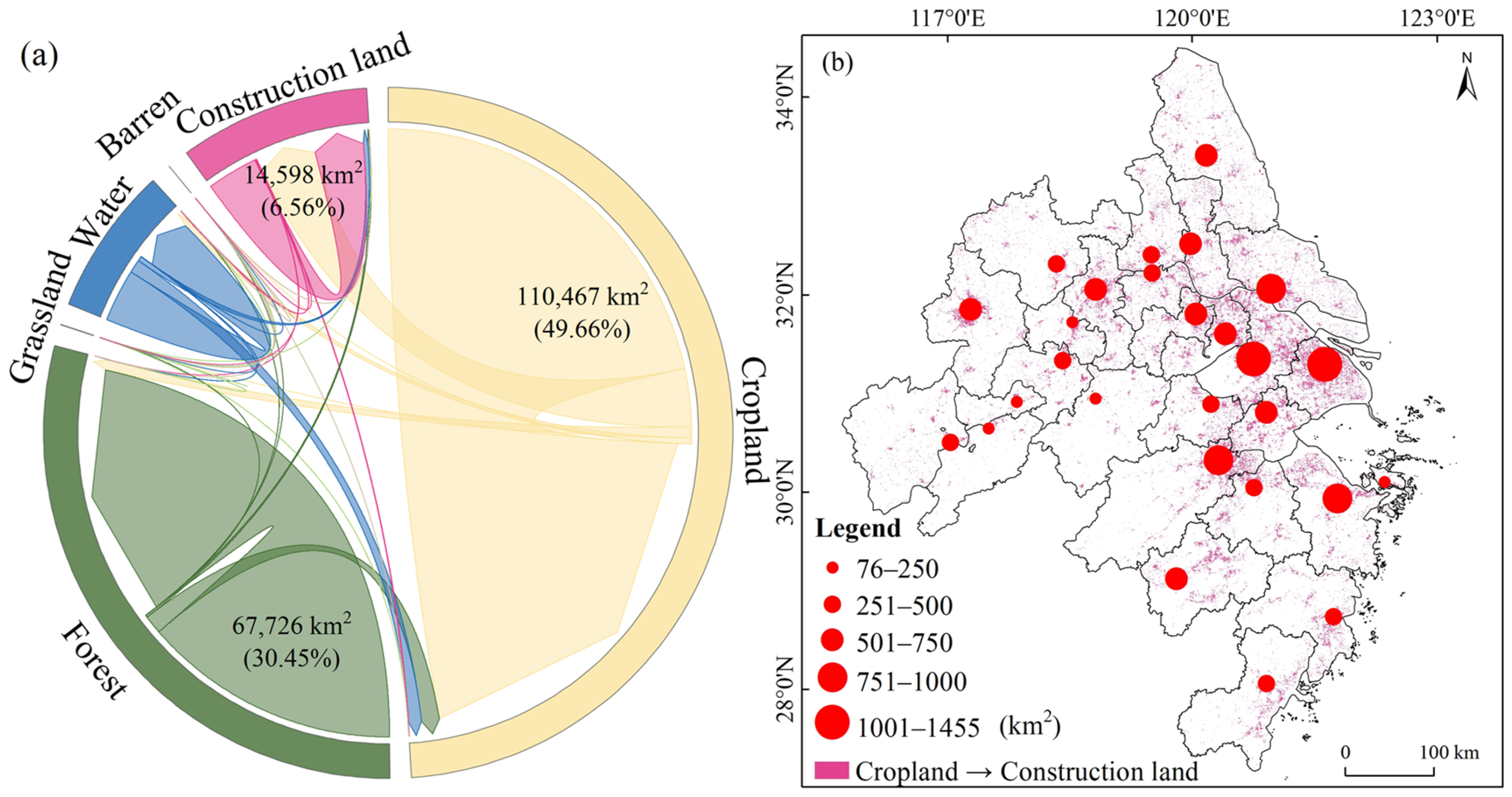
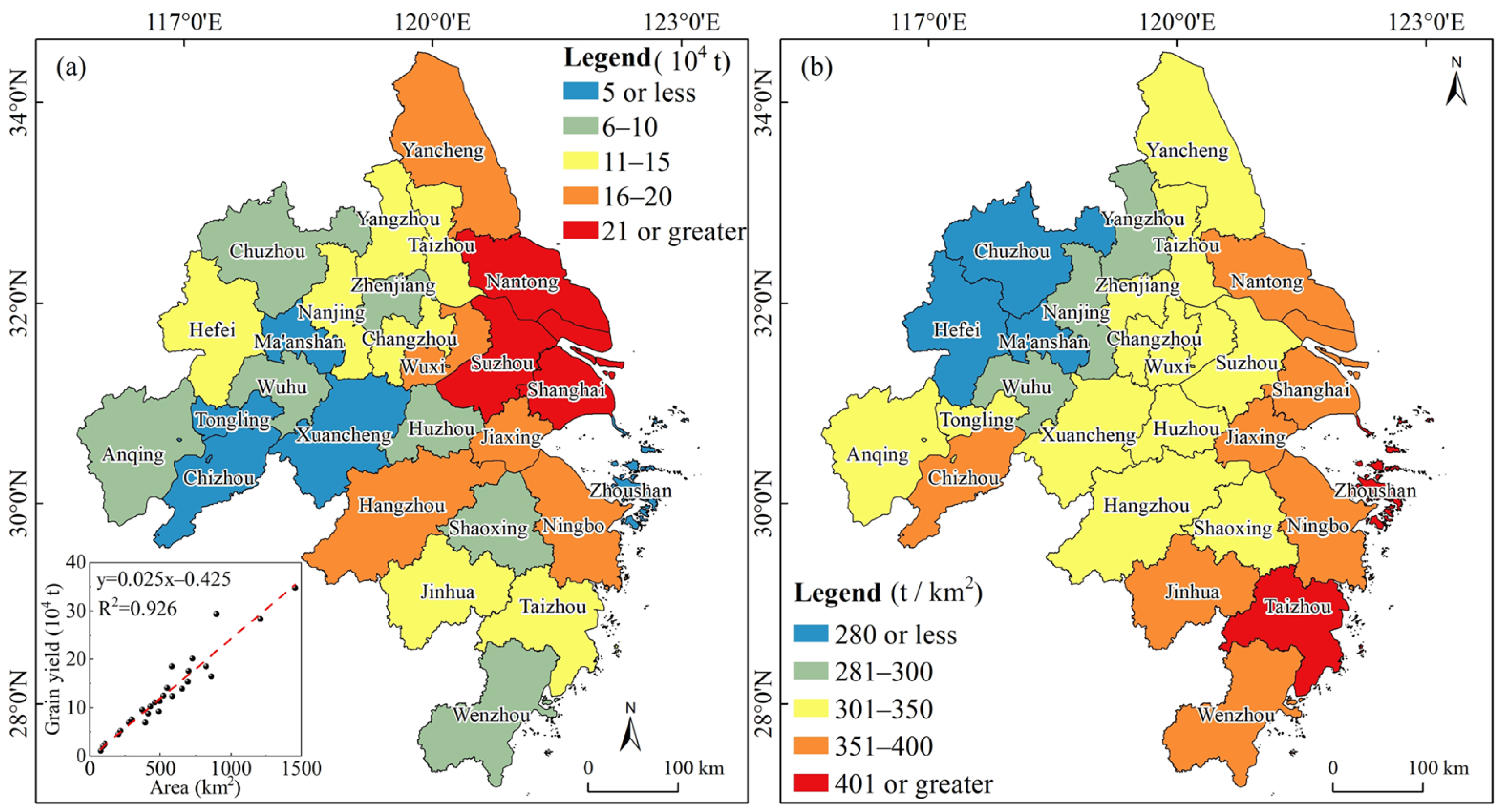

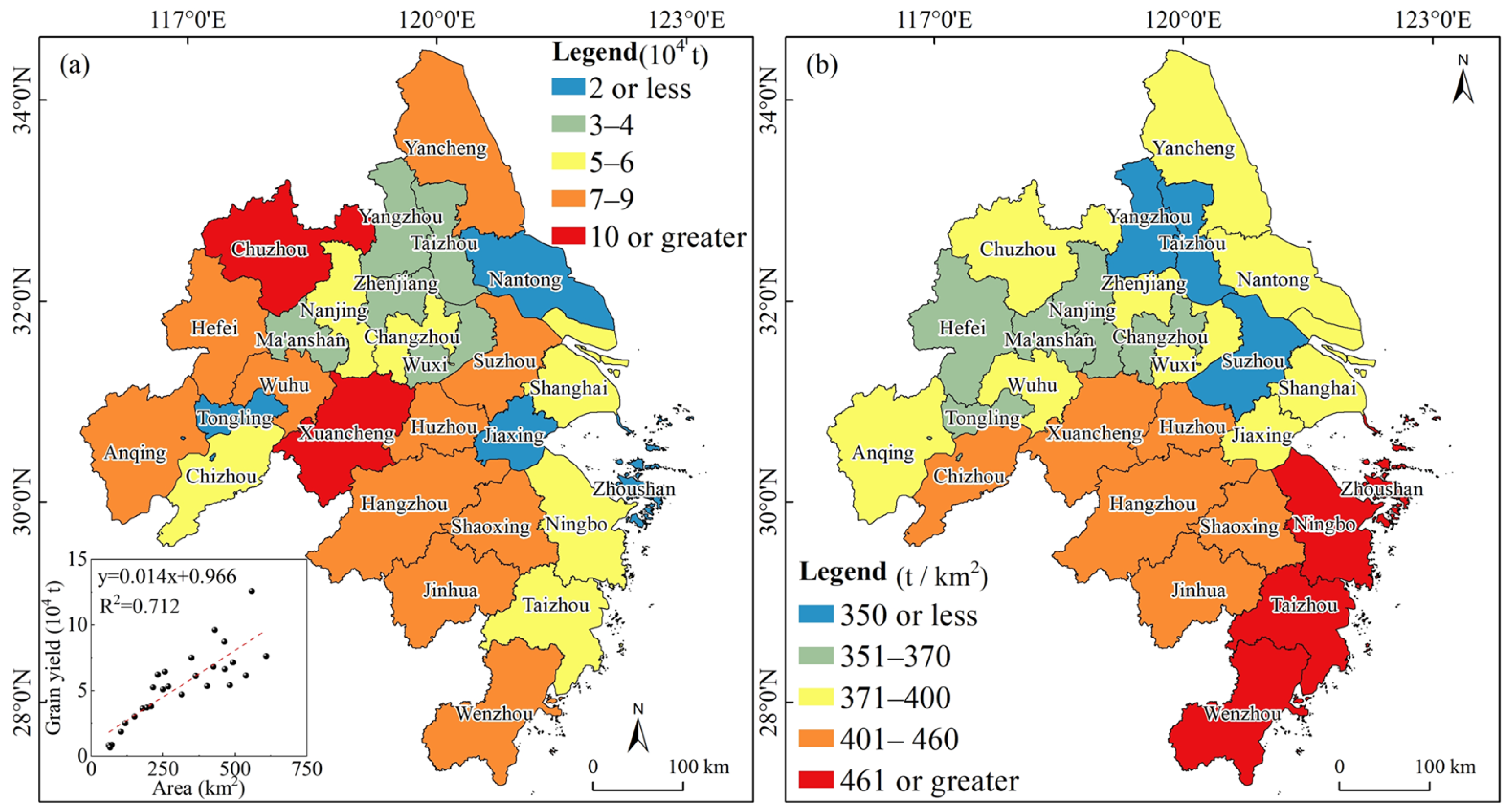
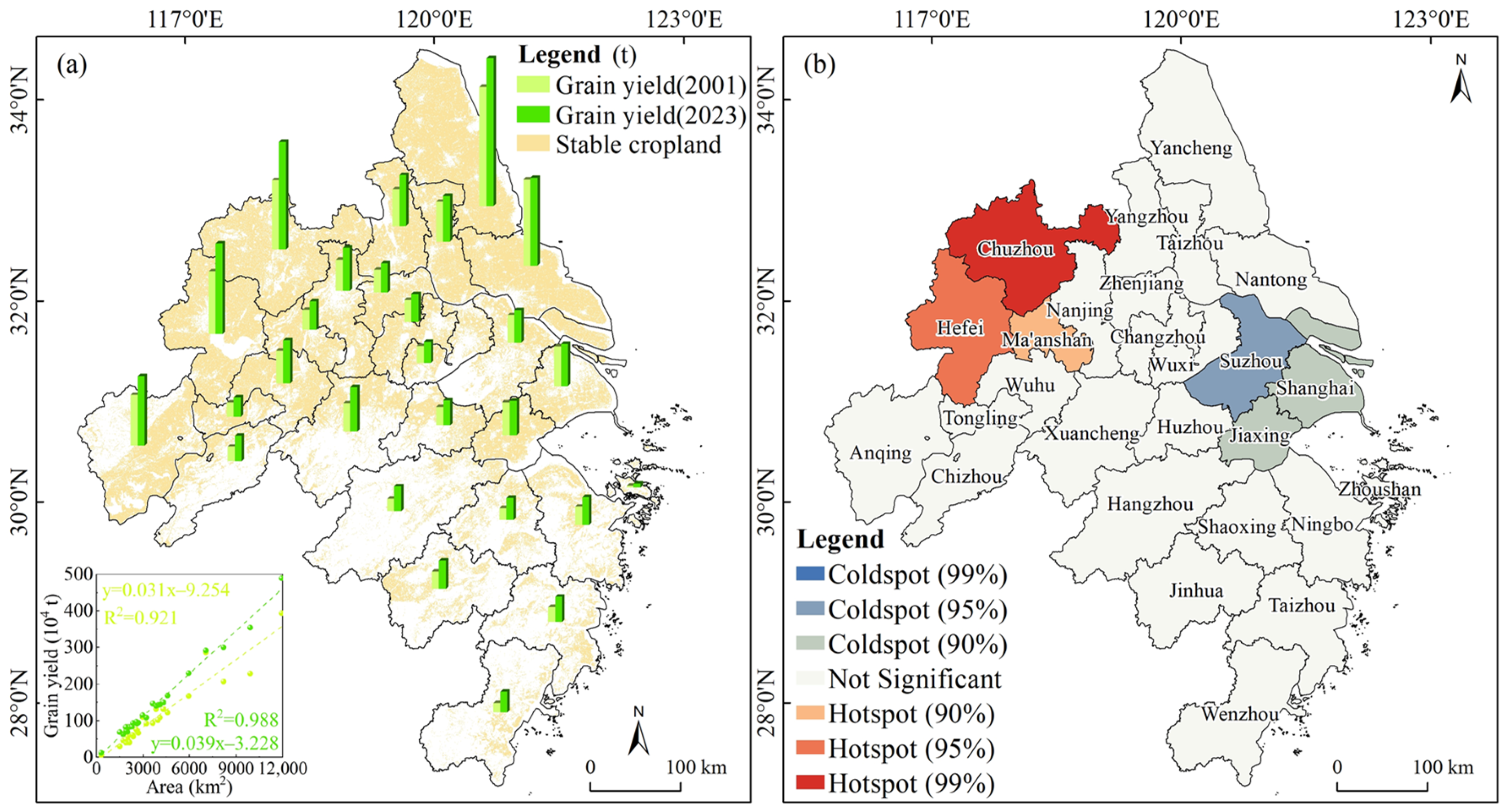

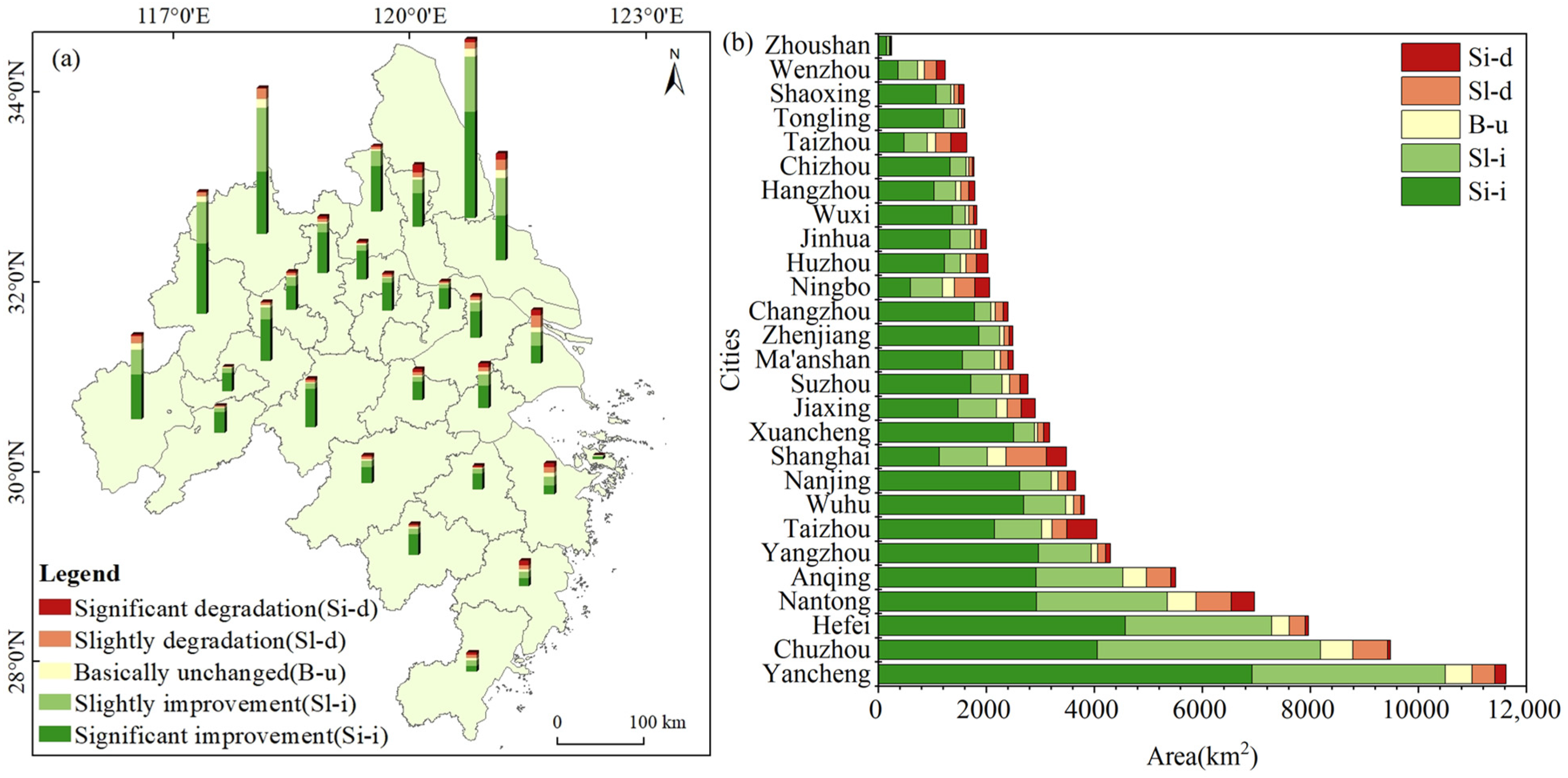
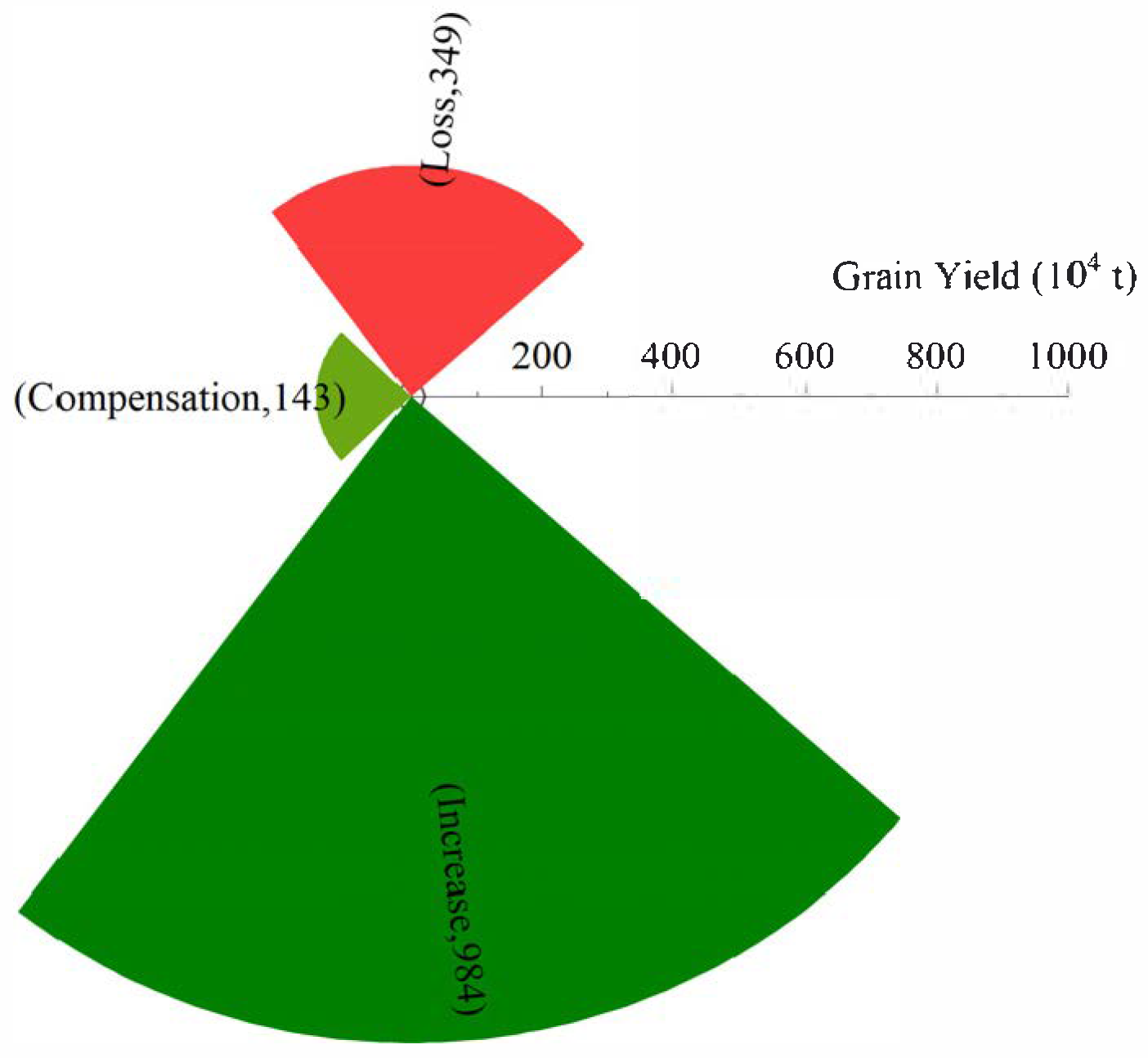
| Data Name | Spatial Resolution | Data Usage Time Range | Data Source |
|---|---|---|---|
| CLCD | 30 m × 30 m | 2001–2023 | Professors Yang Jie and Huang Xin from Wuhan University updated Earth System Science Data to cover the period from 1985 to 2023, which is now freely available for download (https://zenodo.org/records/12779975, accessed on 6 May 2025). |
| NPP | 500 m × 500 m | 2001–2023 | NPP is derived from the sum of all 8-day GPP Net Photosynthesis (PSN) products (MOD17A2H) from the given year. (https://lpdaac.usgs.gov/products/mod17a3hgfv061/, accessed on 6 May 2025) |
| GY | City level | 2001–2023 | Statistical yearbooks (https://tjj.ah.gov.cn/, accessed on 7 May 2025. https://tj.jiangsu.gov.cn/, accessed on 7 May 2025. https://tjj.zj.gov.cn/, https://tjj.sh.gov.cn/, accessed on 8 May 2025) |
| Trends in Grain Yield | SGY (Change Rate) | Z Value (Significance) |
|---|---|---|
| Significant improvement (Si-i) | Improvement (≥0.0005) | Significant (≥1.96) |
| Slight improvement (Sl-i) | Improvement (≥0.0005) | Non-significant (−1.96–1.96) |
| Basically unchanged (B-u) | Stable (−0.0005–0.0005) | Non-significant (−1.96–1.96) |
| Slight degradation (Sl-d) | Degradation (<−0.0005) | Non-significant (−1.96–1.96) |
| Significant degradation (Si-d) | Degradation (<−0.0005) | Significant (≤−1.96) |
Disclaimer/Publisher’s Note: The statements, opinions and data contained in all publications are solely those of the individual author(s) and contributor(s) and not of MDPI and/or the editor(s). MDPI and/or the editor(s) disclaim responsibility for any injury to people or property resulting from any ideas, methods, instructions or products referred to in the content. |
© 2025 by the authors. Licensee MDPI, Basel, Switzerland. This article is an open access article distributed under the terms and conditions of the Creative Commons Attribution (CC BY) license (https://creativecommons.org/licenses/by/4.0/).
Share and Cite
Li, Q.; Huang, Y.; Sun, J.; Chen, S.; Zou, J. Balancing Urban Expansion and Food Security: A Spatiotemporal Assessment of Cropland Loss and Productivity Compensation in the Yangtze River Delta, China. Land 2025, 14, 1476. https://doi.org/10.3390/land14071476
Li Q, Huang Y, Sun J, Chen S, Zou J. Balancing Urban Expansion and Food Security: A Spatiotemporal Assessment of Cropland Loss and Productivity Compensation in the Yangtze River Delta, China. Land. 2025; 14(7):1476. https://doi.org/10.3390/land14071476
Chicago/Turabian StyleLi, Qiong, Yinlan Huang, Jianping Sun, Shi Chen, and Jinqiu Zou. 2025. "Balancing Urban Expansion and Food Security: A Spatiotemporal Assessment of Cropland Loss and Productivity Compensation in the Yangtze River Delta, China" Land 14, no. 7: 1476. https://doi.org/10.3390/land14071476
APA StyleLi, Q., Huang, Y., Sun, J., Chen, S., & Zou, J. (2025). Balancing Urban Expansion and Food Security: A Spatiotemporal Assessment of Cropland Loss and Productivity Compensation in the Yangtze River Delta, China. Land, 14(7), 1476. https://doi.org/10.3390/land14071476







